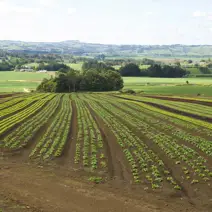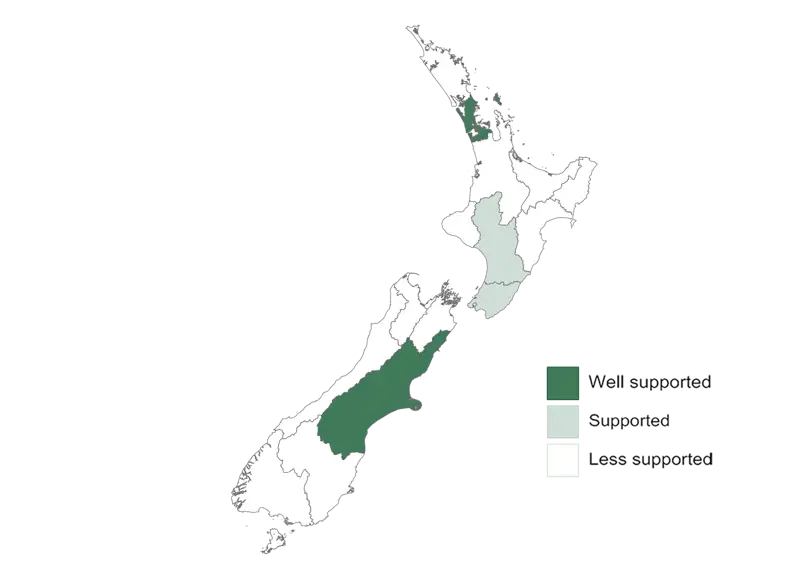
Land Use Fact Sheet
Vegetable seeds
Vegetable seeds are New Zealand's third-biggest vegetable export crop. Most of the crop is grown in Canterbury, but parts of Auckland and the lower North Island are also suitable.
Vegetable seeds use the same equipment and land types as other annual vegetable crops. This means they can fit into your existing crop rotation schedules.
 Overview
Overview
Regions
Most of New Zealand’s vegetable seed crop is grown in Canterbury and Pukekohe. Some crops are grown in the Lower North Island.
Growing conditions
Seed crops are best suited to flat to rolling land with LUC class 1-4 land. They need fertile, well-drained soils.
Climate
Each crop has a different climate preference. All major crops do well in Canterbury, where about 75% of the national crop is grown.
Commercial scale
You need at least 5 hectares to be profitable. Bigger tends to be better, with larger areas giving better profits.
Getting started
Secure your contract for supply from a buyer before committing to your crop. Join a local grower group for support and advice.
Skills / employment
You’ll need to understand the technical processes of preparing, planting and monitoring the crop as it grows.
 Regions
Regions
Most of New Zealand’s vegetable seed crop is grown in Canterbury and Pukekohe. There are also some crops in the Wairarapa and Manawatū-Whanganui.
Get a report on your whenua
Enter the details of your whenua into our search to create a downloadable report showing information about the environment, economy, and climate in your region — and the potential that creates for development.

 Commercial scale
Commercial scale
You need at least 5 hectares to be commercially viable. Larger areas have lower per hectare costs and other benefits of scale, so are usually more profitable. If you are purchasing machinery and developing a packhouse you'll need access to more land in order to make a good profit.
 Getting into the industry
Getting into the industry
You can choose to grow seeds under contract for a wholesaler, or lease your land to another grower.
Leasing
Your whenua can be leased to someone who is already growing in your area. Established growers are often keen to increase their land area by leasing land. They can get better economies of scale and have more options when they are working out their crop rotation.
Leasing is hands-off. If you lease your land to someone else, you do not need to provide any input into the crop.
The market rate for land that can support cropping production is usually $1,000 - $2,000 per hectare per annum. Factors like location, soil, and the condition of the land will determine the rate.
The landowner would usually charge the lessee for the use of water, if irrigation is provided.
The lease contract will include information about:
- how long the lessee can use your land
- what they're allowed to use it for, and
- how they must maintain facilities and look after the land.
Take advice from qualified, experienced advisors before you commit to leasing your whenua.
Contracting to a wholesaler
There are a number of companies in New Zealand who buy vegetable seeds from growers. Make sure you have a contract with one of them before committing to your crop.
The main seed species grown in New Zealand are:
- carrot
- radish
- beetroot
- spinach
- Asian brassica.
New Zealand is the largest carrot seed producer in the southern hemisphere.
You will need to use specialised machinery with qualified operators for planting and harvesting. If you do not own the equipment, make sure you will be able to access contractors and machinery when you need them.
Compared to other crops, vegetable seeds are considered to be at a higher risk of damage from:
- pests
- disease, and
- adverse growing conditions
It is important to know what to look for while your crop is growing, because different species have different pests and diseases. Use careful management to protect your investment during the growing season.
Seed suppliers can provide advice about growing each crop, but always speak with an independent agronomist for advice before making a commitment.
 Skills and employment
Skills and employment
The grower needs to understand the technical processes of preparing, planting and monitoring the crop as it grows. This is likely to include:
- handling dangerous substances, including sprays and fertilisers
- good agricultural practice and management activities
- operating equipment, including tractors and specialised heavy machinery, and
- understanding compliance obligations, including nutrient, water and irrigation management.
It is important to know how to identify and manage any problems or risks as soon as possible, or to have staff or access to consultants who have this expertise. This will help you protect the yield, quality and profitability of your harvest. Seek experienced, qualified advice from an independent agronomist.
Understanding whenua management
Vegetables NZ can help first time growers get in contact with other growers and groups.
The Foundation for Arable Research (FAR) and The New Zealand Grain & Seed Trade Association (NZGSTA) also provide resources that are helpful to growers.
 Compliance
Compliance
Levies
FAR is a funding organisation that pays for research programmes and access to technology for New Zealand growers. They are funded by a levy on seed sales.
- The levy for open-pollinated vegetable seeds crops is 0.9% of the sale value, or $0.90 per $100, and
- The levy for hybrid vegetable seed crops is $0.6% of the sale value, or $0.60 per $100.
These levies can change, so check their website to make sure you have the latest information.
New Zealand Good Agricultural Practice (NZGAP)
NZGAP is a system that helps growers to keep up with compliance requirements. NZGAP is targeted to growers of food crops, but many vegetable seed crop producers choose to be NZGAP certified because it also ensures that they are meeting their other regulatory obligations.
Becoming NZGAP certified:
- gives you confidence that you're meeting compliance requirements
- makes it easier to find out when regulations have changed, and
- ensures your product meets buyer requirements.
Council regulations
Many councils require consents for access to irrigation water and for other activities related to changing land use, like:
- controlling nutrient leaching
- sedimentation
- other environmental impacts.
Speak to your local council before investing in any detailed planning or development work to make sure you are aware of any consents or permits needed to start growing vegetable seeds on your whenua.
Meeting council compliance obligations
National policy statement for freshwater management (NPSFM)
The National Policy Statement for Freshwater 2020 gives local authorities direction on how they should manage freshwater under the Resource Management Act 1991. As such, some local authorities require growers and farmers to create a Farm Environment Plan (FEP). Make sure you're familiar with the FEP expectations in your region. Check with your local council about the requirements for your whenua or planned development.
Even if your region doesn't yet require an FEP, it's good practice to put one in place for your whenua as part of your business plan. The Foundation for Arable Research (FAR) provides templates you can use to create an FEP.
 Growing conditions
Growing conditions
New Zealand has an international reputation as a reliable supplier of quality seeds. This is because of:
- our growing conditions
- the education our growers have, and
- the high standards of our growers.
Like most vegetable crops, vegetable seed crops are best suited to flat to rolling land with LUC class 1-4 land, because of the need for mechanical planting and harvesting. They do best in fertile, free-draining soils with relatively high water holding capacity. Shelter from strong winds will prevent leaf damage and support pollinator insect activity.
Seed crops use less nitrogen than other crops. The average crop uses around 50 kg per hectare. Use soil tests to check how much you should apply. Take advice from your seed merchant or other qualified, experienced advisor.
The growing season varies depending on the region and the crop being grown.
Check regularly for weeds, pests and diseases while your crop is growing. This will help to prevent damage to your crop's quality and yield.
 Climate
Climate
Each crop has a slightly different climate preference. Canterbury supports most of these, which is why it produces around 75% of our vegetable seed crop.
 Water
Water
Vegetable seed crops don't use much water, but they are sensitive to drought. It is important to have access to irrigation if rainfall is not reliable. Too much surface water can kill seeds, so seek advice on the best water management programme for the crop you are growing.
 Market
Market
Vegetable seed exports have grown consistently over the last 20 years. In 2018 they brought in $94.2 million in export earnings.
Our highest individual earner was carrot seed. This contributed $30 million, followed by radish seed with $25.1 million.
 Future industry
Future industry
The global consumption of vegetables continues to grow as the world's population increases. The seed market is an important contributor to global food security. It is projected to remain strong and continue growing well into the future.
 Operational costs
Operational costs
Operational costs vary depending on the location, cost of machinery and the crop being grown.
An open pollinated carrot crop in Canterbury has operational costs of around $1,500 per hectare.
Hybrid seed crops need more intensive management to ensure that the crop is reliable and consistent. Operational costs for a hybrid crop are around $6,000 per hectare.
 Grower returns
Grower returns
Yield is affected by pest, disease and weed pressure during the growing season. If these three things are well-controlled and other growing conditions are good, most open pollinated varieties will yield around 800 kg of cleaned seed per hectare. Hybrid varieties will yield around 400 kg per hectare.
The grower’s sale price for open pollinated carrots is around $9.50 per kg. Hybrid varieties are usually around $35 per kg.
At these yields and prices, the grower return per hectare, per season is around:
- $6,000 for open pollinated varieties, and
- $8,000 for hybrid varieties.
 Seek advice
Seek advice
Seek advice early, before you invest in any design or development.
Talk to your local Te Puni Kōkiri office to see how they can support you through your decision-making process. They will be able to provide advice and find out whether your project qualifies for funding.
Talk to Vegetables New Zealand about connecting with grower groups in your area, and any other support they can provide you as a new grower.
Get in touch with the Foundation for Arable Research (FAR) to make sure that you understand how the levies work and to review their research.
Speak with the New Zealand Grain & Seed Trade Association (NZGSTA) to find out about their research and the support that they offer to growers.
Seek out advice from seed merchants and buyers, and people who grow seed in your area.
Talk to qualified consultants and agronomists who operate in your area and who are experienced in vegetable seed growing and sales. They will be able to provide detailed, impartial advice on what will (and won't) work on your whenua.
 About this fact sheet
About this fact sheet
This fact sheet provides general information to help start and inform conversations. It is not comprehensive or detailed enough to support detailed decision-making.
The information in this fact sheet has been provided by AgFirst, Fresh Facts and Te Puni Kōkiri kaimahi. Data that has not been credited in the body of the fact sheet has been sourced from StatsNZ and from internal sources.
You can provide feedback on the content on this or any fact sheet by emailing us at TPKinfo@tpk.govt.nz